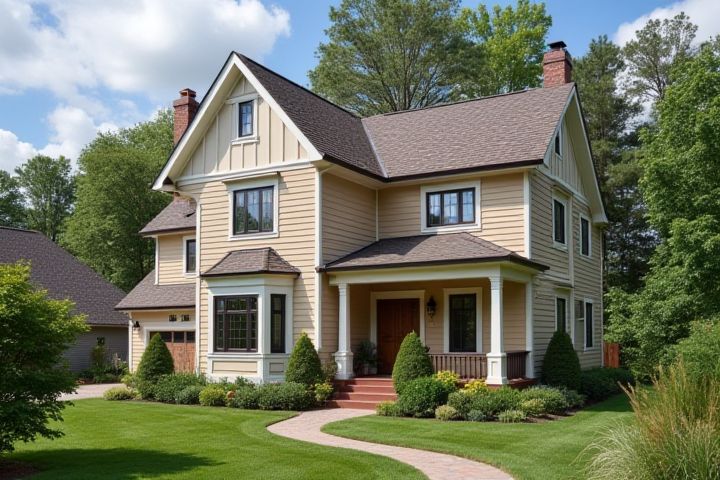
Choosing the right color for your house involves considering several factors, including architectural style, neighborhood aesthetics, and personal preference. Neutral shades like beige, taupe, or gray often enhance traditional homes, while bolder colors, such as deep blue or forest green, can offer a modern and striking appearance. Subtle pastels, like soft yellow or light blue, create a welcoming ambiance, making your home feel warm and inviting. Remember to consider how natural light interacts with colors throughout different seasons, as this can significantly impact the overall look of your home. Finally, check with local regulations or homeowner associations to ensure your chosen color complies with community standards.
What Color Should I Paint My House
Architectural style
Choosing the right color for your house often depends on its architectural style. For a traditional Victorian home, opt for rich, historical hues like deep greens or muted pastels to accentuate elaborate features. Modern minimalist designs benefit from neutral palettes such as whites, grays, or earth tones, which emphasize clean lines and simplicity. If your home embraces a Mediterranean style, warm tones like terracotta or sandy beige can enhance its charm while blending harmoniously with nature.
Neighborhood harmony
Choosing a color that harmonizes with your neighborhood can enhance curb appeal and maintain property value. According to recent surveys, neutral tones like soft beige, light gray, and warm white account for over 60% of homes in suburban areas, promoting a consistent aesthetic. In contrast, vibrant shades such as navy blue or forest green are well-received in more eclectic neighborhoods, adding character without clashing. Consider observing the predominant colors of nearby houses; aiming for a complementary palette ensures your home feels like a cohesive part of the community.
Climate considerations
Choose light colors such as white, pale blue, or soft yellow to reflect heat effectively, reducing energy costs for cooling in warmer climates. According to studies, houses painted in lighter shades can experience up to a 20% decrease in indoor temperatures during summer months. In contrast, darker colors absorb heat, potentially leading to higher air conditioning usage and increased energy bills. Consider your local climate and long-term energy savings when making color selections for optimal performance and comfort.
Lighting effects
When choosing a color for your house, consider how natural light and artificial lighting will affect the appearance of the paint throughout the day. For example, lighter shades like soft whites and pale pastels reflect sunlight, making your home feel more spacious and airy during the day. Conversely, darker hues such as deep blues or charcoal grays can absorb light, creating a cozy atmosphere but may feel constricting in poorly lit areas. You might also explore accent colors that can enhance your home's architectural features, ensuring they stand out beautifully under various lighting conditions.
Popular color trends
Popular color trends for home exteriors in 2023 include soft earth tones, deep blues, and muted greens. Warm neutrals, like beige and taupe, remain favored for their versatility and timeless appeal. Bold accent colors, such as charcoal gray and navy blue, can create striking contrasts, enhancing architectural features. For a fresh look, consider sage green, which not only blends well with nature but also promotes a calming atmosphere.
Personal preference
Choosing a house color heavily relies on personal preference, reflecting your unique style. For a classic look, shades like soft beige or light gray tend to appeal to many homeowners, creating a welcoming atmosphere. Bold colors, such as deep blue or vibrant red, can make a striking statement and enhance curb appeal. Ultimately, consider the neighborhood aesthetic and your surroundings, as a well-chosen hue can harmonize beautifully with your environment.
Resale value impact
Choosing the right color for your house can significantly influence its resale value. Neutral colors like light gray or beige are popular options, as they appeal to a broader range of potential buyers and can enhance curb appeal. According to real estate experts, homes painted in shades of blue can increase selling prices by up to 6%, while vibrant colors may deter some buyers and even necessitate repainting. By selecting a timeless palette, you ensure that your home remains marketable and attractive in a competitive real estate landscape.
Exterior material
When choosing a color for your house, consider the exterior material, as it significantly influences the overall aesthetic. For brick or stone exteriors, earthy tones like terracotta, warm beige, or deep gray enhance the natural texture. If your house features wood siding, muted shades such as sage green, soft blue, or classic white can create a harmonious look with the outdoor environment. Vinyl siding offers versatility; bold colors like navy blue or vibrant red can add character while maintaining the durability of the material.
Trim and accent coordination
When selecting a color for your house, consider a harmonious palette that enhances both your trim and accent features. A classic combination involves light neutral shades like soft white or pale gray for the main exterior, paired with darker trim in charcoal or navy, creating a striking contrast that adds depth. For accents, vibrant hues like teal or sunny yellow can infuse personality without overwhelming the overall aesthetic. Ensure your choices complement the surrounding landscape and architectural style, achieving a cohesive look that reflects your unique taste.
Homeowners association guidelines
When choosing a paint color for your house, it's essential to consult your Homeowners Association (HOA) guidelines, as many communities have specific regulations regarding exterior colors. Typically, neutral shades like taupe, beige, and soft gray are favored, often complemented by a limited palette to maintain aesthetic harmony within the neighborhood. Some HOAs may require a pre-approved color palette, so it's advisable to check if your specific association has a designated list of acceptable colors. Remember, selecting the right hue can not only enhance your home's curb appeal but also potentially increase its market value by adhering to community standards.
